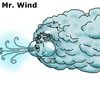You probably know what it's like to be under pressure - being pushed to do something, or maybe pulled in a direction you don't want to go. A force is a push or a pull, so pressure has something to do with forces. In this module you will investigate forces involved with pressure.
Sucking or blowing?
 It's often said that a vacuum cleaner sucks up dirt, or that you
suck a drink through a straw. Is there such a force as "sucking"?
The direct answer is "no". All changes in the movement of gases,
liquids and solids are the result of the application of unbalanced forces.
"Sucking" in, or blowing out, requires a means of unbalancing
competing forces. A common example is breathing.
It's often said that a vacuum cleaner sucks up dirt, or that you
suck a drink through a straw. Is there such a force as "sucking"?
The direct answer is "no". All changes in the movement of gases,
liquids and solids are the result of the application of unbalanced forces.
"Sucking" in, or blowing out, requires a means of unbalancing
competing forces. A common example is breathing.
Drawing breath
"I've hardly had time to draw breath" is a common phrase
when someone is under pressure; what does it mean to breathe in and to
breathe out? Stop to take a few breaths and observe what is happening.
You will have found that as you breathe in muscles draw down on your diaphragm
and your chest expands. Your ribs may move upwards and outwards, especially
with a deep breath. The chest cavity gets larger and, as it is a sealed
unit, air pressure inside the lungs is reduced. Air pressure from outside
then forces air into the lungs. When breathing out, the lung cavity contracts
and air is forced from the lungs because the pressure inside is greater
than the pressure outside.

|
Air pressure and the lungs |
Sucking on a straw
Liquid travelling up a straw uses the same process as breathing. The only
difference is that the liquid is forced into the mouth by air pressure
at the liquid surface. In this case the mouth is sealed by your lips around
the straw. By expanding your mouth volume air pressure inside your mouth
is reduced and the external air pressure pushes liquid up through the
straw and into your mouth. Try it to experience the pressure changes.

|
Sucking on a straw |
Vacuuming
A vacuum cleaner is not correctly named - strictly speaking a vacuum is
a space where there are no atoms or molecules, but it does sound better
than a "Low Pressure Cleaner"! A vacuum cleaner works on the
same principle as you experience when breathing, except that an electric
motor is used to reduce pressure inside the cleaner's bag, by spinning
a fan with blades that move air out of the bag. Air pressure from outside
forces air into the cleaner bag, carrying small bits and pieces from the
floor or carpet, into the bag. Air passes through the filter cloth or
paper and the larger dirt particles get trapped, so the dirt is safely
stored and clean air expelled from the bag.
Wind and pressure
 Air
pressure is constantly changing in the atmosphere, and these atmospheric
forces control our weather. A high pressure system often means good weather
and a low brings rain or more cloudy conditions. It is when there is a
change in pressures that we notice the wind the most. Where a high pressure
system is followed closely by a low pressure region the air will begin
to move quickly causing strong winds. The greater the difference in pressure
the stronger the winds. An easy way to remember which way the winds will
blow is "the winds will blow from high to low". You experience
this if you have a puncture in your tyre, or if a valve leaks!
Air
pressure is constantly changing in the atmosphere, and these atmospheric
forces control our weather. A high pressure system often means good weather
and a low brings rain or more cloudy conditions. It is when there is a
change in pressures that we notice the wind the most. Where a high pressure
system is followed closely by a low pressure region the air will begin
to move quickly causing strong winds. The greater the difference in pressure
the stronger the winds. An easy way to remember which way the winds will
blow is "the winds will blow from high to low". You experience
this if you have a puncture in your tyre, or if a valve leaks!
| Copyright owned by the State of Victoria (Department of Education and Early Childhood Development). Used with Permission. |